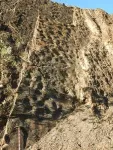(Press-News.org)
A collaboration led by UCLA and the Seattle Children’s Research Institute has yielded new knowledge about the genes responsible for the production and release of immunoglobulin G, the most common type of antibody in the human body.
The finding has the potential to advance manufacturing of antibody-based therapies for diseases such as cancer and arthritis, as well as the development of medical treatments that rely on the production of antibodies.
Antibodies are a group of proteins that are crucial to the immune system. Immunoglobulin G, or IgG, stores memories of past infections and tags dangerous microbes to be eliminated by immune cells. Mothers’ IgG is also vital for their newborns’ immune defense.
Scientists have known for decades that a population of white blood cells, called plasma B cells, make IgG. Plasma B cells are highly efficient, producing more than 10,000 IgG molecules every second. But the molecular mechanisms that enable plasma cells to secrete antibodies into the bloodstream are still not fully understood.
In order to learn more about those mechanisms, the researchers performed an analysis that had never been done before: They captured thousands of single plasma B cells as well as their individual secretions, and then connected the amount of proteins each individual cell released to an atlas mapping tens of thousands of genes expressed by that same cell.
To collect the cells and their secretions, the researchers used microscopic, bowl-shaped hydrogel containers called nanovials, which were developed in prior UCLA research.
Their analysis found that genes involved with producing energy and eliminating abnormal proteins were even more important for high IgG secretion than the genes containing instructions for making the antibody itself. They also discovered that the presence of CD59, a gene that had not previously been linked to IgG secretion, is a better predictor of high-producing plasma cells than other genetic markers already associated with this cell type.
“These processes in cells are like an assembly line for making proteins, and there are lots of places where you could see bottlenecks,” said Dino Di Carlo, the Armond and Elena Hairapetian Professor of Engineering and Medicine at the UCLA Samueli School of Engineering and a co-corresponding author of the study. “Things have to be moving smoothly in sync across the cell. If a cell is making a lot of proteins, it’s using a lot of energy and needs a way to correct the proteins that get messed up.”
The study was published in the journal Nature Communications. Di Carlo, who is also a member of the California NanoSystems Institute at UCLA and the UCLA Jonsson Comprehensive Cancer Center, said the findings could not only advance fundamental understandings of biology but also could have applications in biomedicine.
For instance, knowing which genes are associated with higher secretion of an antibody could be used by pharmaceutical makers to engineer cells that secrete large volumes of the antibody. That knowledge could also be applied to an emerging strategy that introduces engineered cells directly to patients’ bodies, such as the potential cell therapies under development by University of Washington immunologist Richard James, a co-corresponding author of the paper.
The new way in which nanovials and a standard laboratory setup were used in the study also opens up new possibilities for understanding how the instructions contained in DNA are translated into the behaviors of cells.
Each nanovial contains molecules tailored to bind with proteins on the surface of the cells that the researchers are investigating, which enables the nanovial to capture a single cell at a time. Once that cell is immobilized and protected within the nanovial “bowl,” its secretions also accumulate and are attached to specific antibodies engineered to capture them.
In the study, the investigators trapped tens of thousands of plasma cells, along with the IgG they released, in nanovials with a diameter about one-third the thickness of a sheet of paper. The nanovials were then run through an instrument to analyze each cell’s messenger RNA, or mRNA.
Every cell in an individual’s body carries the same blueprint written in DNA. So scientists detect which genes are active by looking at the mRNA, which translates those instructions so that each cell can build proteins that are specific to its functions.
“There are multiple layers of information in each cell,” Di Carlo said. “We’re able to link the final layer — the amount of proteins actually secreted that have a clear function throughout the body — back to the more fundamental layer of genetic code. There’s currently no other technique that is available to do that. Now that we have this approach, the most interesting thing, to me, is which question to ask next.”
In future studies, the researchers hope to identify all of the genes that affect plasma cells’ production and secretion of IgG.
Nanovials are available commercially from Partillion Bioscience, a company co-founded by Di Carlo that is based in CNSI’s on-campus startup incubator, Magnify.
The first authors of the study are Rene Cheng of the University of Washington and Joseph de Rutte, who earned a doctorate from UCLA in 2020 and is a co-founder and CEO of Partillion. Other authors are affiliated with UW, Partillion and the Seattle-based company Luminex. The study was supported by the National Institutes of Health and the Seattle Children’s Research Institute.
END
BIRMINGHAM, Ala. – Follicular helper T cells, or Tfh cells, have a crucial role in immune defense. Without Tfh cells, B cells cannot form germinal center, or GC, responses during which high-affinity antibodies are generated.
When naïve CD4-positive CD4+ T cells receive news of an infection elsewhere in the body, they become activated with additional cell-surface markers, and they differentiate in two directions, becoming either PD-1+CXCR5– or PD-1+CXCR5+ T cells. PD-1 and CXCR5 are ...
AUSTIN ― Today The University of Texas System Board of Regents Chairman Kevin P. Eltife announced plans to launch a monumental healthcare initiative to accelerate and expand UT Austin’s burgeoning medical district into a world-class academic medical center for education, research and patient care. The University of Texas at Austin Medical Center will start with two new hospital towers -- The University of Texas MD Anderson Cancer Center and a UT Austin hospital. MD Anderson, the nation’s #1 cancer hospital, ...
Scientists have completed a deep analysis of the proteins driving cancer across multiple tumor types, information that can’t be assessed by genome sequencing alone. Understanding how proteins operate in cancer cells raises the prospect of new therapies that block key proteins that drive cancer growth, or therapies that trigger immune responses to abnormal proteins created by cancer cells.
Led by Washington University School of Medicine in St. Louis, the Broad Institute of MIT and Harvard, Brigham Young University and other institutions around the world, the Clinical Proteomic Tumor Analysis Consortium investigates key proteins driving cancer and how ...
Embargoed for release until 5:00 p.m. ET on Monday 14 August 2023
Annals of Internal Medicine Tip Sheet
@Annalsofim
Below please find summaries of new articles that will be published in the next issue of Annals of Internal Medicine. The summaries are not intended to substitute for the full articles as a source of information. This information is under strict embargo and by taking it into possession, media representatives are committing to the terms of the embargo not only on their own behalf, but also on behalf ...
Black Americans are 54% more likely to die of cardiovascular disease than White Americans, despite a substantial overall reduction in cardiovascular disease mortality nationwide.
Now, a new study from Tulane University published in Annals of Internal Medicine has found that this racial disparity can be attributed to social factors such as unemployment, low income, and lack of a partner rather than known factors such as hypertension and obesity.
“For so many years we have focused on smoking, diet, physical ...
In 2020, 771 million people worldwide still lacked access to clean drinking water, according to UNICEF and the World Health Organization.
For this reason, many nongovernmental organizations (NGOs) prioritize building new water projects, including handpumps and small piped systems, to bring clean water to rural areas of developing countries.
Alfonso Pedraza-Martinez
New research from Alfonso Pedraza-Martinez, the Greg and Patty Fox Collegiate Professor of IT, Analytics and Operations in the University of Notre Dame’s Mendoza College of Business, examines the critical problem of drinking ...
A federally funded study, led by University of Cincinnati researcher Nalinikanth Kotagiri, looks to develop a new imaging method that can identify certain types of lung infections — in real time — in order to speed up treatment for critically ill patients.
Kotagiri, an associate professor of pharmaceutical sciences at the UC James L. Winkle College of Pharmacy, has been awarded a five-year $3 million, R01 grant from the National Heart, Lung, and Blood Institute (NHLBI) to develop and study the effectiveness of different kinds of injectable probes (metallic contrast agents) that would collect at the site of the infection and immediately light up under a nuclear ...
CHAMPAIGN, Ill. — The whaling industry helped drive industrialization in the 19th century, with whale oil used to light lamps and lubricate machinery. Even after petroleum replaced whale oil as an energy source in the U.S., whaling continued to be part of our cultural imagination and helped develop the idea of an energy industry, said University of Illinois Urbana-Champaign English professor Jamie L. Jones.
Her new book, “Rendered Obsolete: The Afterlife of U.S. Whaling in the Petroleum Age,” examines the influence of a dying industry during the massive energy transition from the organic fuel sources of the 19th century, including whale oil and wood, to the extraction of fossil ...
Only about 10 percent of patients survive as long as five years after a diagnosis of pancreatic cancer.
“Pancreatic cancer is very hard to treat,” said Irving Coy Allen, professor of inflammatory diseases in the Department of Biomedical Sciences and Pathology at the Virginia-Maryland College of Veterinary Medicine. “It's one of the top five deadliest cancers in the U.S. And it's deadly because by the time you find out that you have a tumor, it's usually metastasized. You can usually treat the local tumor, but how do you treat the metastatic lesions?”
The National Institutes of Health has awarded $2.6 million to a Virginia Tech team ...
Key takeaways
In the fast-growing marketplace for recreational marijuana and related products, products containing cannabinoids called HHCs are gaining popularity.
The neurological and physiological effects of HHCs are not well understood.
A new study by UCLA chemists is the first to explain how well HHCs bind to receptors in the human body; the scientists also devised a safer way to produce HHCs than the current standard process.
As more of the nation has adopted legal marijuana, a glut of products has emerged in dispensaries that contain the psychoactive ingredient in marijuana, ...






